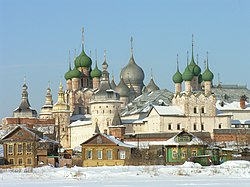Kremlin (fortification): Difference between revisions
Taking out pic of the modern imitation-kremlin |
→Kremlins outside borders of modern Russia: added info |
||
| Line 90: | Line 90: | ||
* [[Kamyanyets]], Belarus (shafts and [[Tower of Kamyanyets|Belaya Vezha tower]]) |
* [[Kamyanyets]], Belarus (shafts and [[Tower of Kamyanyets|Belaya Vezha tower]]) |
||
* [[Belgorod Kievsky]], Ukraine (now village Belgorodka) |
* [[Belgorod Kievsky]], Ukraine (now village Belgorodka) |
||
The same structure in Ukraine is called [[Detinets|dytynets]] ({{lang-uk|дитинець}}, from ''dytyna'' - child). The term has been in use since the 11th century. The term ''Kremlin'' first appeared in 14th century in Russian territories, where it replaced ''dytynets''. |
|||
Many Russian [[monastery|monasteries]] have been built in a fortress-like style similar to that of a kremlin. For a partial list, see [[:Category:Monasteries in Russia|Monasteries in Russia]]. |
Many Russian [[monastery|monasteries]] have been built in a fortress-like style similar to that of a kremlin. For a partial list, see [[:Category:Monasteries in Russia|Monasteries in Russia]]. |
||
Revision as of 21:02, 9 December 2014




A kremlin (Russian: кремль, romanized: kreml, IPA: [ˈkrʲemlʲ], fortress; same root as in kremen (Russian: кремень, romanized: kremen, IPA: [krʲɪˈmenʲ], flint)) is a major fortified central complex found in historic Russian cities. This word is often used to refer to the most famous one, the Moscow Kremlin, or metonymically to the government that is based there.
The short list of Russian cities with kremlins
- World Heritage Sites
- Extant
- Astrakhan Kremlin
- Kolomna Kremlin
- Nizhny Novgorod Kremlin
- Pskov Kremlin
- Rostov Veliky Kremlin (a bishop residence, not formally considered a kremlin)
- Smolensk Kremlin
- Tobolsk Kremlin (the sole stone kremlin in Siberia)
- Tula Kremlin
- Zaraysk Kremlin
- Ivangorod Fortress (not formally considered a kremlin)
- Oreshek Fortress (not formally considered a kremlin)
- Staraya Ladoga
- Alexandrov Kremlin (a czar residence, not formally considered a kremlin)
- Korela Fortress (not formally considered a kremlin)
- Izborsk Kremlin
- In ruins
- Gdov Kremlin
- Porkhov Kremlin
- Serpukhov Kremlin
- Velikie Luki Kremlin
- Torzhok Kremlin
- Mozhaysk Kremlin
- Fortress of Koporye (not formally considered a kremlin)
- Vyazma Kremlin (one tower)
- Syzran Kremlin (one tower, 1683)
- Ufa
- Unwalled
- Vladimir Kremlin (Tower Golden Gate and bank)
- Dmitrov
- Ryazan
- Vologda (a bishop residence, not formally considered a kremlin)
- Yaroslavl (two towers)
- Pereslavl-Zalessky
- Khlynov (Vyatka)
- Volokolamsk
- Only traces
- Borovsk
- Opochka
- Zvenigorod
- Starodub
- Tver – a wooden fortress was burned down in a fire in 1763
- Sknyatino – underwater since flooding during the 1930s.
- Yam Fortress (not formally considered a kremlin)
- Fortress of Radonezh
- Ryazan
- Old Ryazan (60 km from modern Ryazan)
- Ostrov (14th-15th centuries)
- Belgorod (bank of fortress)
- Vereya
- Kaluga
- Kleshchin
- Kostroma
- Pustozyorsk
- Uglich
- Staritsa
- Sviyazhsk
- Cheboksary
- Yuryev-Polsky
- Aleksin
- Opochka
- Oryol
- Rurikovo gorodishche
- Mtsensk
- Raskiel
- Modern imitations
Kremlins outside borders of modern Russia
After the disintegrations of the Kievan Rus, the Russian Empire and the USSR, some fortresses considered Kremlin-type, remained beyond the borders of modern Russia. Some are listed below:
- Belz, Ukraine (only traces)
- Kiev, Ukraine (reconstructed tower of the Golden Gate)
- Putyvl, Ukraine
- Novhorod-Siverskyi, Ukraine
- Chernihiv, Ukraine (only traces)
- Kamyanyets, Belarus (shafts and Belaya Vezha tower)
- Belgorod Kievsky, Ukraine (now village Belgorodka)
The same structure in Ukraine is called dytynets (Template:Lang-uk, from dytyna - child). The term has been in use since the 11th century. The term Kremlin first appeared in 14th century in Russian territories, where it replaced dytynets.
Many Russian monasteries have been built in a fortress-like style similar to that of a kremlin. For a partial list, see Monasteries in Russia.
Further reading
- Воронин Н. Н. Владимир, Боголюбово, Суздаль, Юрьев-Польской. М.: Искусство, 1967.
- Кирьянов И. А. Старинные крепости Нижегородского Поволжья. Горький: Горьк. книжн. изд., 1961.
- Косточкин В. В. Русское оборонное зодчество конца XIII — начала XVI веков. М.: Издательство Академии наук, 1962.
- Крадин Н. П. Русское деревянное оборонное зодчество". М.: Искусство, 1988.
- Раппопорт П. А. Древние русские крепости. М.: Наука, 1965.
- Раппопорт П. А. Зодчество Древней Руси. Л.: Наука, 1986.
- Раппопорт П. А. Строительное производство Древней Руси (X—XIII вв.). СПб: Наука, СПб, 1994.
- Сурмина И. О. Самые знаменитые крепости России. М.: Вече, 2002.
- Тихомиров М. Н. Древнерусские города. М.: Гос. изд. полит. лит-ры, 1956.
- Яковлев В. В. Эволюция долговременной фортификации. М.: Воениздат, 1931.
See also
- Citadel
 Media related to Fortresses in Russia at Wikimedia Commons
Media related to Fortresses in Russia at Wikimedia Commons
